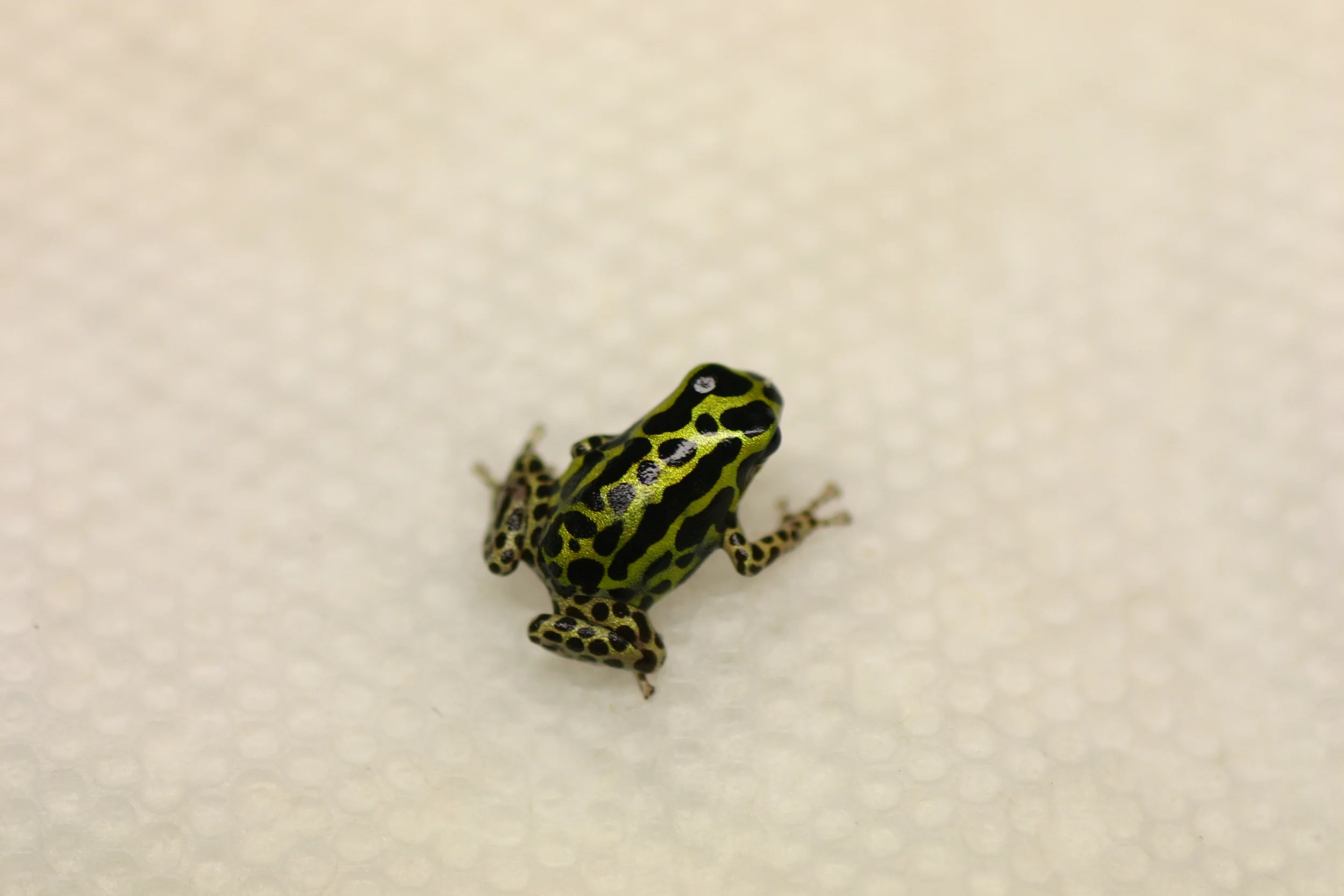













Your Custom Text Here
After genetic study, what used to be called Ranitomeya lamasi and biolat are now grouped into sirensis with the distinctively different holotype, a solid red frog with blue legs. I've observed the most activity around lights on and lights off, these frogs are typically shy. They make up for their shyness with a lovely call, much like that of R. imitator, the ability to be kept in groups and a willingness to breed.
Breeding takes place just about anywhere and 1 - 5 white to gray eggs are laid at a time. The male readily transports the tadpoles to individual bodies of water and directs the female to lay nutritive eggs for the tadpole. If tadpoles are pulled they need to be housed singly and fed a high protein diet.
Care: Beginner, the high price and limited availability of the Highland/Tingo Maria morph should prevent them from being a starter thumbnail, typically shy
Groups: Yes, even mix
Breeding: Easy, horizontal film canisters on their sides, upside down vertically from 90 to 30 degrees
Tadpoles: Excellent parental care after deposition, recommend leaving tadpoles with parents
Froglets: Small - Medium, springtails are a help, tadpoles left with parents morph larger
Tips: Lower light levels result in bolder frogs
After genetic study, what used to be called Ranitomeya lamasi and biolat are now grouped into sirensis with the distinctively different holotype, a solid red frog with blue legs. I've observed the most activity around lights on and lights off, these frogs are typically shy. They make up for their shyness with a lovely call, much like that of R. imitator, the ability to be kept in groups and a willingness to breed.
Breeding takes place just about anywhere and 1 - 5 white to gray eggs are laid at a time. The male readily transports the tadpoles to individual bodies of water and directs the female to lay nutritive eggs for the tadpole. If tadpoles are pulled they need to be housed singly and fed a high protein diet.
Care: Beginner, the high price and limited availability of the Highland/Tingo Maria morph should prevent them from being a starter thumbnail, typically shy
Groups: Yes, even mix
Breeding: Easy, horizontal film canisters on their sides, upside down vertically from 90 to 30 degrees
Tadpoles: Excellent parental care after deposition, recommend leaving tadpoles with parents
Froglets: Small - Medium, springtails are a help, tadpoles left with parents morph larger
Tips: Lower light levels result in bolder frogs
Highland - Tingo Maria
R. lamasi 'Highland' is also know in the hobby as the Standard Lamasi as it was the first to make its way to the United States. It is not nearly as common in the US as the other morphs from Panguana. This is due to a major price crash that made the frog undesirable, limited breeding efforts and bottlenecked the gene pool resulting in difficulty breeding remaining stock. Several imports from Europe were made between 2012 and 2014 and breeders have started having success with those. Unfortunately this morph may have been extirpated from the wild and what we have may be it.
There seems to be a movement in the hobby to call them Tingo Maria instead of Highland since that is where the founder populations may be from. I included it here, though I don't know if that's the best name to use for these frogs.
Highland - Tingo Maria
Highland - Tingo Maria
Various offspring
Highland - Tingo Maria
Highland - Tingo Maria
Green Leg Panguana
Green Leg Panguana, like all R. sirensis are a bit reclusive but appear to be active after the lights go out and early in the day after the lights turn on. Whether these are a distinct population from the Panguana sirensis I don't know. They came in separately in the late 90's and I've maintained them as such since then.
Pictured it a typical frog along with one with an aberrant pattern.
Green Leg Panguana
A froglet with an aberrant pattern
Panguana
'Panguana' are quite similar to the 'Green Leg Panguana' but they possess white to blue/gray reticulations on their legs as opposed to the blue-green of the 'Green Leg Panguana'.
Panguana
Panguana
Orange Panguana
'Orange Panguana' are similar to the 'Panguana' morph, as they possess white to blue/gray reticulations on their legs. The color of the 'Orange Panguana' vary from light orange to a brick red.
Additionally they possess rather noticeable yellow flash marks on the upper part of their thighs and forearms. They are similar to 'Green' sirensis in this respect. The frogs in the hobby came to the US via a collector in the Czech Republic, apparently they are sympatric with Ranitomeya uakarii at the collection site.
Orange Panguana
Orange Panguana
Green
These sirenesis are the only ones currently in the hobby with locality data. Produced by Understory Enterprises, these frogs have proven very similar to the sirensis from Panguana that are already in the hobby.
Pictured is a juvenile frog.